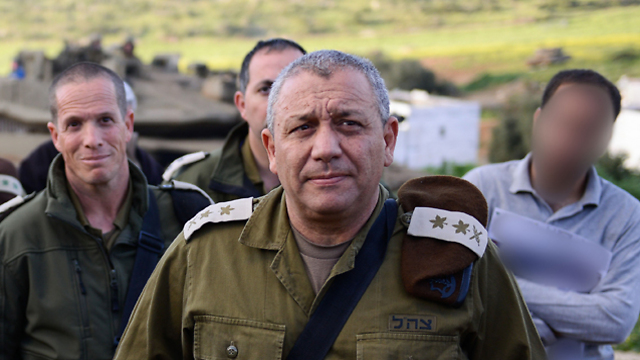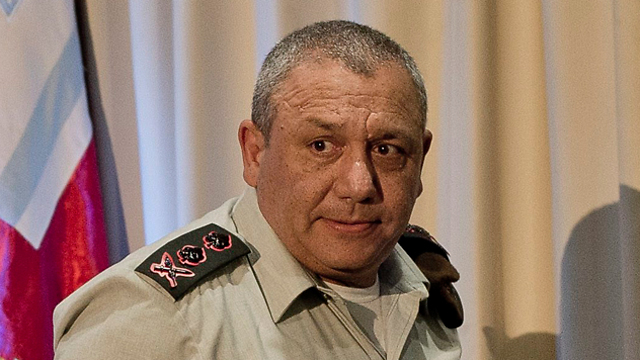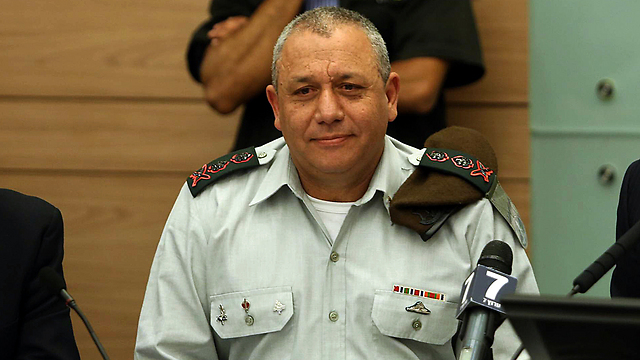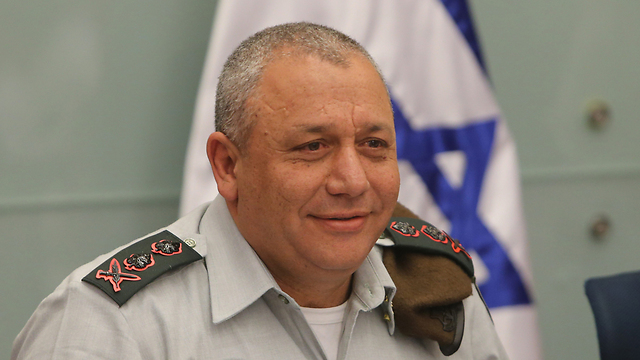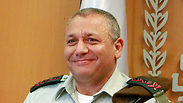
IDF Chief of Staff Eisenkot reaches term's halfway mark
A year and a half into his term, it's clears Eisenkot is leading an assertive military, which is determined to attain clear goals. The IDF chief takes risks—like reducing the number of planes and tanks, promotes long-forgotten plans and makes fast decisions.
Fifty tons of explosives and only four lightly injured—that is an unusual result in Gaza's terms.
The secret to keeping the number of injuries low is probably the long duration of the attack. The Israeli Air Force must have formulated a gradual attack plan to allow those in the affected areas to escape. The small number of injuries was also key in Hamas' decision not to retaliate.
IDF Chief of Staff Lt. Gen. Gadi Eisenkot asked the Air Force to present him with a plan that would make it easier on the leadership in the Gaza Strip not only to swallow the bitter pill, but also to arrest members of the Salafist organization that launched the rocket at Sderot earlier that day.
Meanwhile, Hamas is having a hard time hiding the surprise among the members of its military wing following that attack. It's very likely that Hamas, along with other foreign players—such as the Iranian experts sitting in the Gaza Strip and trying to study the IDF and the weapons it develops—have been analyzing this unusual IAF strike. They know exactly what was hit, and they're trying to figure out how that happened. And on this they have reason to worry. Needless to say the lessons being learned in Gaza are immediately passed on to southern Lebanon, Hezbollah, Syria, the Iranian Revolutionary Guard Corps and Iranian intelligence.
The first conclusion Hamas needs to draw from this attack is that Israel will take advantage of any security-related incident coming out of Gaza carry out some form of an unusual operation.

The intensity of that airstrike is not part of a pattern the IDF will now repeat, as a reflex, every time a rocket is launched from the Gaza Strip. It is clear this was not an operation concocted an hour before it was launched. Theoretically, an attack of this nature could have been carried out the previous time a rocket was fired at Sderot. The timing for it—a decision deliberated on for weeks and months—was discussed in a forum that includes the Operations Directorate, the Military Intelligence Directorate, the Air Force, the deputy chief of staff and the chief of staff. Minister of Defense Avigdor Lieberman was briefed on this plan when he took office and gave it his backing.
On August 22, when the opportunity arose, officers in the Operations Directorate brought the plan to the chief of staff, a decision was made, and Lieberman gave it the final go-ahead by phone.
This intense aerial bombardment of Gaza succinctly expresses the IDF chief's operational worldview in the era of interbellum conflicts: Keep potential rivals constantly under the impression that the IDF is a very assertive, aggressive, and unpredictable military, which is constantly at high alert and always looking for opportunities to show off its might. Have the enemy feel constantly under threat. There is no such thing as a "spillover" on the Golan Heights that is not met with some form of response. The same is true for every front, even if some of the activity is done covertly.
Intimate military ties with the US
The relationship the IDF currently has with the American military can definitely be defined as "intimate." On this, Eisenkot continues the tradition of his predecessors, who knew how to maintain good work relations with the American defense establishment—despite disagreements in the political ranks.
If we find ourselves in a state of emergency in which Israel is in need of protection from the threat of ballistic missiles, Israeli and American teams will sit together in one command center in central Israel. They will operate a global system that will provide them with real-time alerts on launches, and will work as one unit to intercept the missiles—using either American or Israeli anti-missile measures. Such a scenario has already been drilled, which is more than what the American military does with some of its other allies.
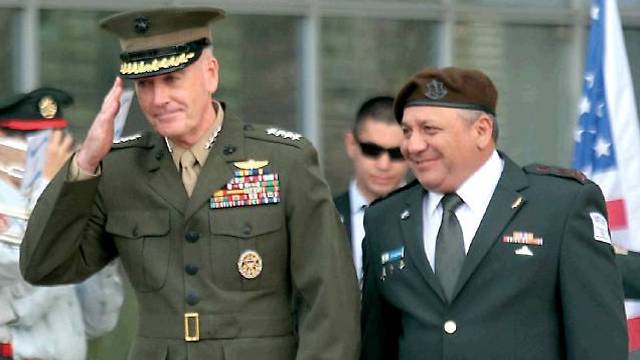
The American involvement in the war in Syria is also being carried out with transparency displayed torwards the IDF. Video conference calls between the IDF chief and his American counterpart are a matter of routine. Several senior American generals visited Israel last month, from the Air Force commander to the commander of the Army Central headquarters. Considering the situation in Syria and in Iraq, it's safe to assume these were not courtesy visits.
In private forums, where Eisenkot allows himself to open up and speak more freely, he admits that the high level of alert along Israel's borders is a result of a lesson learned from the trauma he carries from his time as the head of the Operations Directorate.
During that time, in July 2006, two reserve soldiers—Ehud Goldwasser and Eldad Regev—were kidnapped from within Israeli territory. That border incident—which began as the undermining of Israeli sovereignty in an era when the rules of the game were not clear enough to the enemy—developed into an unplanned all-out war.
Since that incident, protecting Israel's sovereignty, down to the last meter, has become a cornerstone of Eisenkot's security worldview.
When he was the GOC Northern Command, he implemented this worldview by setting ambushes in areas Israel considered to be under its sovereignty to stop the Lebanese from coming near. His motto was and remains: There is a price for every violation of sovereignty.
At the end of last month, Eisenkot crossed the halfway mark of his term as IDF chief of staff—a year and a half in the job. In this short time he has managed to give himself and the IDF a long list of tasks and make many changes, as if time was running out on him.
Eisenkot asserts that a strategic window of opportunities has opened in the region, and that Israel must not squander it. It could take risks: When looking at the map of regional threats, it appears like the Arab world is going to be busy fighting against itself for a long time. But Eisenkot can already point to one black spot on that map that could change all of the assessments at once.
Iran: An opportunity and a risk
Strategically, this threat will come into our lives in May 2017: The elections in Iran. A possible rise or return to power of the extremist conservatives in Iran, such as Mahmoud Ahmadinejad and his ilk, could dissolve the nuclear agreement. If today Israel is prepared for the possibility of Iran reaching military-grade nuclear capability within 10–15 years, a drastic change of regime will require it and other world powers to reassess that timeline.
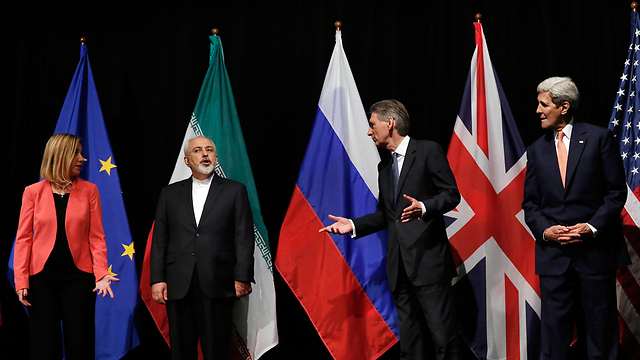
Eisenkot has been repeatedly saying, in different forums, that the nuclear agreement between Iran and world powers is a done deal. In his view, this is a strategic turn of events that opens a window of opportunity for Israel to chalk up security achievements. This doesn't dismiss the fact Iran will make every effort to obtain nuclear weapons, but Israel just got time that needs to be properly taken advantage of. For example, by making the most out of cooperation with friendly nations.
On the more immediate level, Iran concerns Israel due to the fact the Islamic Republic is operating against the Jewish state in every possible way while cooperating with terror organizations. Iran also has a very advanced military industry that cannot be ignored. The tests Iran conducts of long-range missiles—that could reach almost every inch of Israel—show the level of its technological capabilities. However, the IDF's top command still believes that in the current diplomatic atmosphere, Iran will not automatically start firing missiles at Israel should a conflict break out on the northern border.
All of this remains true until May 2017. At that time, all assessments and estimates could crumble at once.
Dealing with the Gaza tunnel threat
When he took office, the IDF chief defined 2015 as a year of preparedness and high alert, in which the military will invest all of its efforts in training and in upping the reserve forces' level of readiness. This was reflected in the diverting of some NIS 800 million in resources to the benefit of the Army's readiness.
In February 2016, he defined another central mission for the military: Dealing with the tunnel threat in Gaza. The large-scale training exercises the IDF has been conducting may have been looking north towards Lebanon, but the technological, operational and engineering efforts are geared towards one objective: Putting an end to the tunnel threat.
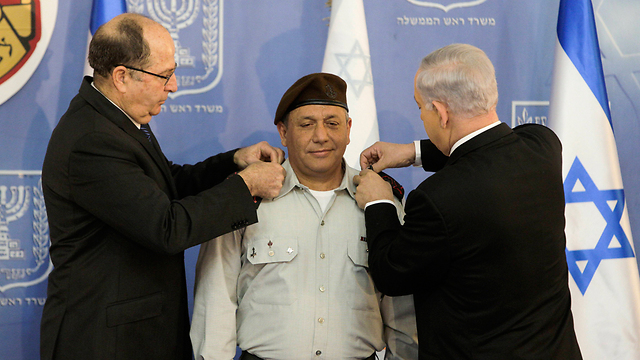
Over the past two years, the State of Israel has invested NIS 1 billion in dealing with the underground threat. The IDF chief attends discussions on the topic at the Southern Command once or twice a month, and at time even more often.
The efforts are being coordinated by Military Intelligence, the Shin Bet, the Engineering Corps, the Air Force, the Ground Forces and the control center in charge of constructing the physical obstacle around the Gaza Strip, under the command of Brig. Gen. Eran Ofir. Every few weeks, the IDF chief receives a "status report" on the operation's progress from that forum. The entire operation is done under the command of GOC Southern Command Maj. Gen. Eyal Zamir and the commander of the Gaza Division, Brig. Gen. Yehuda Fox—the latter is known in the Kirya IDF Headquarters as someone who "lives and breathes tunnels." But Eisenkot makes sure to keep the issue close, under his watchful eye.
The open and covert efforts don't necessarily focus solely on the immediate demolition of the tunnels as soon as a conflict breaks out. This is a war of attrition, at the end of which Hamas will realize this strategic measure—whether these are tunnels that cross into Israel or tunnels inside the strip—is no longer effective. The objective is to cause the Gaza terror group to give up on continuing the tunnels enterprise, make it clear that the tunnels are a death trap for its fighters. Eisenkot is confident this objective will be achieved, and soon.
Northern border: A nuisance, not a threat
The window of opportunity—as it appears from the Eisenkot's office on the 14th floor of the IDF Headquarters building in Tel Aviv—includes, at present, Syria and Lebanon as well. Syria won’t go back to being the country it was before the civil war. Furthermore, the senior IDF command believes the war there will last for a long time, despite American and Russian mediation. Hezbollah—the IDF's main enemy in Syria—currently has some 7,000 fighters in the country, out of the 20,000–22,000 fighters the organization has in total. So far, Hezbollah has lost 1,700 of its men in Syria, with 6,000 others wounded.
Despite aid from Iran, Hezbollah is dealing with a serious financial crisis, and the mood among its ranks indicates it has no interest in opening another front at present.
Hezbollah has also stopped trying to establish a stronghold in the Golan Heights—with Iranian help—meant to harass Israel. And so, despite the ongoing war in Syria, the Golan Heights remain quiet. All of the forecasts of terror attacks and refugees that would flood the Golan and come knocking on Israel's door have been proven false.
ISIS, which controls areas in the southern Golan Heights, is indeed a nuisance, but is not perceived as a strategic threat. Every now and again there are warnings of an impending terror attack by ISIS that for some reason are dismissed.
Appointments in the IDF
Appointments at the top echelons of the IDF are not just a matter of gossip. The chiefs of staff view it as a way to leave their mark on the military. It took Eisenkot a year and a half to put together a general staff that was entirely "his own." He is the one to select the musicians in the orchestra he's conducting, because he believes they'll be able to perform his creations in the best way possible. As few off-key notes as possible, as few ego fights as possible.
The main exceptions to that, appointments made by the previous IDF chief, are Navy Commander Maj. Gen. Ram Rothberg—who was asked to extend his term but already has a replacement, Brig. Gen. Eli Sharvit, and Air Force Commander Maj. Gen. Amir Eshel—who was also asked to stay in his role longer and has yet to have a replacement.
The IDF's top ranks are now anxiously awaiting the first third of 2017, when Eisenkot's second deputy chief is chosen to replace Maj. Gen. Yair Golan: GOC Northern Command Maj. Gen Aviv Kochavi or former GOC Southern Command Maj. Gen. Sami Turgeman.
As soon as the next deputy chief is selected, it would be time to start talking about the next IDF chief of staff.

So far, most of the senior officers appointments have gone smoothly and without any unusual power struggles. Eisenkot has been appointing officers in the rank of colonel and higher over a year in advance. He adopted the recommendation of the attorney general to also make that the timeframe for the appointment of major generals. If there have been any reservations, insults and resignations as a result of the appointments—and an organization like the IDF always does—they have so far happened mostly under the media radar. The offended officers simply don't mess with the IDF chief. Eisenkot can certainly give himself a pat on the back: He was able to change the majority of the IDF's top command without any out-of-the-ordinary turmoil.
And still, there were three unpleasant incidents. Very unpleasant, really.
The first: The appointment of Brig. Gen. Ofek Buchris, Eisenkot's protégé, who caused his own undoing.
The second: The IDF Criminal Investigation Division (CID) commander affair—which included mudslinging between the outgoing commander and the incoming one. This is another outbreak of a disease that has been plaguing the Military Police in general and the CID in particular for over a decade. The symptoms of this disease are divisiveness, internal conflicts, hatred, sabotage of others, leaks to the press, and more.

There has hardly been any appointment of a CID commander that wasn't accompanied by officers informing on one another, investigations being launched in light of personal and professional allegations, and cases being opened and closed by the Military Advocate General. And that, heaven help us, is the authority meant to enforce law and order in the military.
The head of the IDF's Manpower Directorate, Maj. Gen. Hagai Topolansky, tried to remedy this by appointing Brig. Gen. Ran Kochavi—who comes from the Air Defense Command—as the new CID commander, in the hopes that he brings with him some order from the Air Force.
To the IDF chief, the turmoil in the CID is a very serious failure, an elite unit that must be thoroughly rehabilitated.
The third unpleasant incident—and the most significant one—was the appointment of Rabbi Eyal Karim as the new IDF chief rabbi. The officer's problematic Halachic rulings, which came to light after his promotion was announced, showed that the prep work ahead of the appointment was not sufficiently thorough. There was unease about the appointment even within the ranks of the General Staff, but Eisenkot would not back down. This lack of flexibility drew criticism: After the IDF chief makes a decision on an appointment, he will stand behind it—even if it's controversial. Because of his desire to back his officers, Eisenkot is suffering from an abscess that, left untreated, could burst at some point.
Black and white values
The moment he stepped into the IDF chief's office, Eisenkot started talking about values and set some very clear norms. Humility, for one. He decided to put an end to lavish parties in the IDF that featured expensive performers—and now there aren't any. Performers either volunteer or appear as part of their reserves service. Big events will only be held on the division level and higher.
The IDF chief also noticed that the ultra-Orthodox Zionist sector has been exerting great influence over the IDF through the Military Rabbinate in an effort to set new norms and values and undermine the authority of the IDF's senior command—so he put an end to that, too. He closed the "Jewish Consciousness" department in the Military Rabbinate and decided, just recently, to close the IDF off to any divisive outside influences. Outside speakers or community activities will now have to get the approval of the Chief Education Officer, and even those will be few and far between.
A soldier who wants to attend a lecture on divisions in Israeli society or watch a controversial play is free to do so on his or her own time. The IDF's "Culture Sundays" will be used to visit state institutions, Yad Vashem and other museums.
Unlike the decision to reorganize the Army, which entails long discussions and deliberations, here Eisenkot can simply make a decision and execute it. His decisions on core values are clear: Black and white. There are no shades of gray. This was also his approach to the Elor Azaria shooting incident in Hebron: He will stick to his position from the outset—that this was not a normative act—until the end, no matter what the verdict may be.
On the other hand, there are those who claim the IDF chief's fast decision-making process can sometimes cause damage. Had he considered the matter a little while longer, he could have been spared the blows he suffered over problematic appointments.
Suddenly there's money for acquisitions
The list of decisions Eisenkot has made so far is definitely impressive. After five years in which the IDF operated without a multiannual work plan, he formulated such a plan—one that even has a good chance of surviving. The IDF chief cut back on 100,000 reservists, changed the standing military's model, is preparing the IDF for the shortening of mandatory service, and has begun work on the reorganization of the Army, the establishment of the National Cyber Bureau and the dismissal of 5,000 people from the standing military.
During the first third of 2016, all of the military's operative plans in all areas have been completed. Suddenly, money was found to increase the IDF's stocks.
All of these issues have been on the General Staff's table in the past as well, but Eisenkot has taken risks and made decisions. He's reducing the number of planes in the Air Force upon introducing the F-35 fighter jets and taking a risk in reducing the number of tanks in the army until all of the new Merkava Mark IV tanks have become operational. This window of opportunity allows him to upgrade the IDF's equipment. One needs managerial courage to take such risks, and Eisenkot has it.
A promising cooperation with Lieberman
Last month, the new defense minister presented his "carrots and sticks" policy for the West Bank. Lieberman brought the idea of further emphasizing the difference between the "good guys" and the "bad guys" in the territories with him when he took office at the end of May. The new plan was the first real test to the working relationship between the defense minister and the IDF chief. So far, both come out looking good from their work together.
Perhaps because Lieberman didn't come into a vacuum. By June, there has already been a clear trend pointing to a significant drop in terror attacks in the West Bank. What started in October 2015 as a popular uprising with 70 attacks a month, ended with nine terror attacks during June and July and only a handful during August.
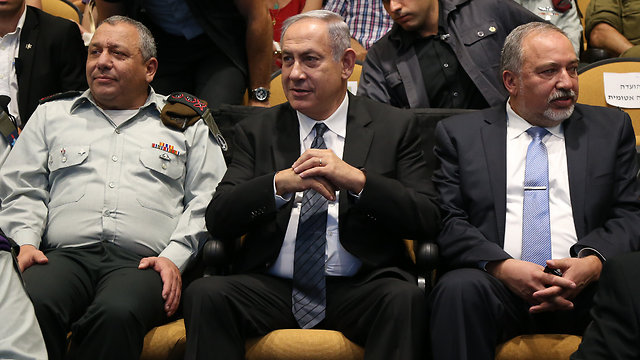
The IDF was determined not to repeat the same mistakes it made during the first and second intifadas—primarily imposing collective punishment on the population—which led to uncontrollable violence that lasted for five or six years. Eisenkot's orders were to cut this wave of terror attacks short, not give it a tailwind.
The wave of violence, which swelled in late 2015, was unfamiliar in its nature to the IDF and Israel's other security services. The "classic" modus operandi of thwarting a terror attack—based on intelligence capabilities developed by Israel—did not work with this wave of attacks, which was characterized by lone wolf terrorists.
Because of that, a new strategy was formulated—led by the IDF chief and COGAT, with the support of the Shin Bet—that puts an emphasis on separating the non-involved population from the perpetrators of terrorism. This decision had political ramifications, that former defense minister Moshe Ya'alon—who stood behind it—might have paid the price for.
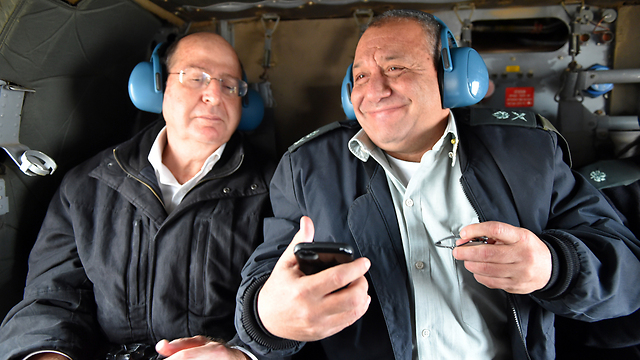
And so, even after the gravest of attacks and despite public pressure and the downpour of criticism from right-wing ministers and settlers, the non-involved population was not affected. There were no closures, no curfews, no revoking of job permits, and 400,000 Palestinians went to work every day in Israel, the PA and settlement industrial areas undisturbed. Life in Judea and Samaria continued as normal, and that was the main factor in the ebbing of violence.
Lieberman, whose political views are very clear, incorporated the IDF's position into his "carrots and sticks" policy. For nine months, the IDF tried unsuccessfully to convince the cabinet to ease construction restrictions on the Palestinians in Area C—and it was Lieberman who approved it. For over a year, the GOC Central Command tried to push the construction of another hospital in the West Bank, unsuccessfully—until Lieberman came along and approved it. It's not just the sticks that are going to be proper sticks—the carrots are also proper ones.
And so a promising connection was formed between a new defense minister and an IDF chief halfway through his term. The question is, how long will it last?










